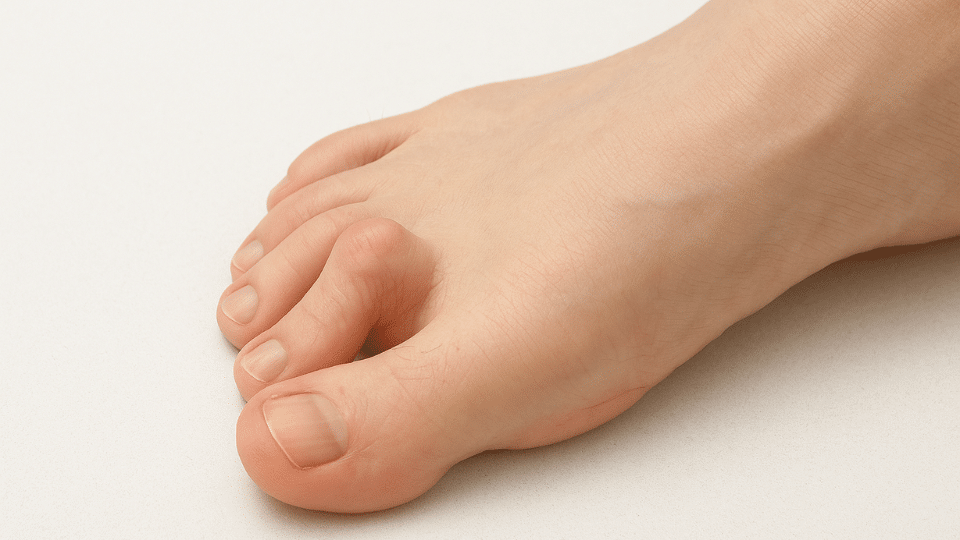Toe deformities may seem minor at first, but over time they can become painful, limit your mobility, and even affect your balance. One of the most common conditions podiatrists treat is hammer toe, a deformity that changes the way your toe bends and functions. Many patients are surprised to learn how early intervention and conservative treatments can prevent the condition from worsening.
In this article, we will answer important questions like what is hammer toe, what does a hammer toe look like, what causes a hammer toe, and most importantly, how to fix hammer toes without surgery.
What Is Hammer Toe?
Hammer toe is a deformity where one of your smaller toes, most often the second, third, or fourth, becomes abnormally bent at the middle joint. Instead of lying flat, the toe curls downward, resembling the shape of a hammer.
This condition can be flexible at first, meaning the toe can still be moved, but over time it often becomes rigid. When left untreated, hammer toe can cause corns, calluses, pain while walking, and difficulty fitting into shoes comfortably.
If you have dealt with other foot conditions such as bunions, you may notice similarities in how they affect toe alignment. You can learn more about how bunions are treated in our guide Bunion Solutions: From Correctors to Lapiplasty Surgery and Supportive Shoes.
What Does a Hammer Toe Look Like?

If you are wondering what does a hammer toe look like, there are a few telltale signs:
- The toe bends downward at the middle joint instead of pointing straight
- The top of the bent joint may rub against shoes, leading to corns or calluses
- Redness, swelling, or irritation often develops around the joint
- In more advanced cases, the toe may become fixed in its bent position and unable to straighten
Patients often describe their toes as looking curled, claw-like, or tucked under compared to the rest of the foot. These changes are not just cosmetic, they indicate changes in muscle balance and joint health.
What Causes a Hammer Toe?
Understanding what causes a hammer toe is key to both prevention and treatment. Several factors can contribute, including:
- Footwear choices: Tight or narrow shoes, especially high heels, crowd the toes and force them into unnatural positions
- Muscle imbalance: When toe muscles weaken, they can no longer keep the toe straight. The stronger muscles pull the joint downward
- Genetics: If foot deformities run in your family, you may be more prone to developing hammer toes
- Injury or trauma: A stubbed or broken toe can sometimes heal in a bent position
- Underlying conditions: Arthritis, bunions, or nerve damage can also increase the risk
For many people, hammer toe is the result of a combination of footwear habits and natural foot structure.
Symptoms and When to See a Podiatrist
Common symptoms of hammer toe include:
- Pain when wearing shoes or walking
- Swelling, redness, or burning sensations around the toe joint
- Stiffness or inability to straighten the toe
- Corns and calluses forming where the toe rubs against shoes
If your toe pain is interfering with daily activities, or if you notice the toe becoming rigid, it is important to see a podiatrist promptly. Early intervention offers the best chance of avoiding surgery.
How to Fix Hammer Toes Without Surgery
Many patients ask, how to fix hammer toes without surgery. The good news is that conservative treatments can be very effective, especially when started early. At Fall Creek Foot & Ankle, we often recommend:
- Footwear modifications: Choosing shoes with a wide toe box, low heels, and supportive soles helps relieve pressure on the toes
- Custom orthotics: Inserts designed specifically for your foot shape can restore balance, reduce friction, and slow progression
- Toe exercises: Gentle stretches and strengthening exercises can help keep the joint flexible and the muscles balanced
- Protective padding: Cushions, corn pads, or silicone toe sleeves reduce pain from rubbing and pressure points
- Splints or straps: These devices help realign the toe and prevent further bending
- Anti-inflammatory care: Ice therapy, topical treatments, or oral medication may be recommended to reduce swelling and discomfort
These non-surgical approaches focus on pain relief, mobility, and preventing further deformity. For many patients, they provide lasting improvement.
When Surgery May Be Needed
If the toe becomes rigid, extremely painful, or resistant to conservative care, surgery may be necessary to straighten the joint. However, many cases can be successfully managed without surgery when addressed early. That is why a timely evaluation is so important.
Restoring Comfort and Foot Health
Hammer toes can make every step a painful reminder of how much we rely on healthy feet. But by understanding what is hammer toe, recognizing what does a hammer toe look like, knowing what causes a hammer toe, and exploring how to fix hammer toes without surgery, you can take proactive steps toward better foot health.
At Fall Creek Foot & Ankle, our podiatry specialists provide personalized care, from footwear guidance to advanced orthotics, designed to help you walk comfortably again.
Take the Next Step Toward Relief
If you suspect you may have a hammer toe or are experiencing toe pain, do not wait until the condition becomes more serious. Early treatment makes a significant difference.
Schedule an appointment with Fall Creek Foot & Ankle today and let our experts guide you toward lasting relief and healthier steps.
